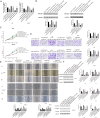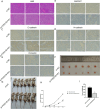LncRNA PCED1B-AS1 mediates miR-3681-3p/MAP2K7 axis to promote metastasis, invasion and EMT in gastric cancer
- PMID: 38698487
- PMCID: PMC11064384
- DOI: 10.1186/s13062-024-00468-z
LncRNA PCED1B-AS1 mediates miR-3681-3p/MAP2K7 axis to promote metastasis, invasion and EMT in gastric cancer
Abstract
Background: LncRNA PCED1B-AS1 is abnormally expressed in multiple cancers and has been confirmed as an oncogene. Our study aimed to investigate the regulatory mechanism of lncRNA PCED1B-AS1 in gastric cancer.
Methods: TCGA database was used to analyze the abnormal expression of lncRNA PCED1B-AS1 in gastric cancer. By database prediction and mass spectrometric analysis, miR-3681-3p and MAP2K7 are potential downstream target molecules of lncRNA PCED1B-AS1 and verified by dual-luciferase report assay. RT-qPCR analysis and western blot were performed to detect the expressions of PCED1B-AS1 and MAP2K7 in gastric cancer cell lines and tissues. CCK-8 kit was applied to measure the cell viability. Wound healing and Transwell experiment were used to detect the migration and invasion. Western blot and immunohistochemical staining were performed to detect the expressions of EMT-related proteins in tissues. The changes of tumor proliferation were detected by xenograft experiment in nude mice.
Results: PCED1B-AS1 expression was higher but miR-3681-3 expression was lower in gastric cancer cell lines or tissues, compared to normal group. Function analysis verified PCED1B-AS1 promoted cell proliferation and inhibited cell apoptosis in gastric cancer cells in vitro and in vivo. LncRNA PCED1B-AS1 could bind directly to miR-3681-3p, and MAP2K7 was found to be a downstream target of miR-3681-3p. MiR-3681-3p mimics or si-MAP2K7 could partly reverse the effect of PCED1B-AS1 on gastric cancer cells.
Conclusion: PCED1B-AS1 accelerated cell proliferation and inhibited cell apoptosis through sponging miR-3681-3p to upregulate MAP2K7 expression in gastric cancer, which indicated PCED1B-AS1/miR-3681-3p/MAP2K7 axis may serve as a potential therapeutic target for gastric cancer.
Keywords: Gastric cancer; MAP2K7; lncRNA PCED1B-AS1; miR-3681-3p.
© 2024. The Author(s).
Conflict of interest statement
All authors declare that there is no any competing interest.
Figures









Similar articles
-
LRRC75A-AS1 facilitates breast cancer cell proliferation and invasion via functioning as a CeRNA to modulate miR489-3p/ARD1.Sci Rep. 2025 Aug 26;15(1):31501. doi: 10.1038/s41598-025-17372-9. Sci Rep. 2025. PMID: 40858914 Free PMC article.
-
LncRNA PCED1B-AS1 facilitates cervical cancer progression via targeting miR-361-3p.Nucleosides Nucleotides Nucleic Acids. 2025 Aug 1:1-14. doi: 10.1080/15257770.2025.2537150. Online ahead of print. Nucleosides Nucleotides Nucleic Acids. 2025. PMID: 40748616
-
Long noncoding RNA MATN1-AS1 contributes to oxaliplatin resistance of gastric cancer cells through miR-518b/ZNF281 axis.Naunyn Schmiedebergs Arch Pharmacol. 2025 Aug;398(8):11041-11060. doi: 10.1007/s00210-025-03990-7. Epub 2025 Mar 12. Naunyn Schmiedebergs Arch Pharmacol. 2025. PMID: 40072551
-
Roles of AFAP1-AS1 in Gynecology and Urogenital System.Curr Pharm Des. 2024;30(8):639-647. doi: 10.2174/0113816128286229240129090915. Curr Pharm Des. 2024. PMID: 38347771 Review.
-
Long non-coding RNA NR2F1-AS1: an increasingly significant LncRNA in human cancers.J Physiol Biochem. 2025 Aug 19. doi: 10.1007/s13105-025-01119-1. Online ahead of print. J Physiol Biochem. 2025. PMID: 40828427 Review.
Cited by
-
LINC02679 regulates TRIML2 to promote gastric cancer proliferation and invasion via targeting miR-5004-3p.Noncoding RNA Res. 2025 Apr 1;13:1-14. doi: 10.1016/j.ncrna.2025.04.001. eCollection 2025 Aug. Noncoding RNA Res. 2025. PMID: 40276014 Free PMC article.
-
Development of an immunogenic cell death-related lncRNAs signature for prognostic risk assessment in gastric cancer.Transl Cancer Res. 2024 Aug 31;13(8):4420-4440. doi: 10.21037/tcr-24-344. Epub 2024 Aug 27. Transl Cancer Res. 2024. PMID: 39262480 Free PMC article.
-
Long Noncoding RNA MALAT1: Salt-Sensitive Hypertension.Int J Mol Sci. 2024 May 18;25(10):5507. doi: 10.3390/ijms25105507. Int J Mol Sci. 2024. PMID: 38791545 Free PMC article. Review.
-
Long non-coding RNA VCAN-AS1 promotes gastric cancer progression via the HuR/F11R pathway.Am J Transl Res. 2024 Nov 15;16(11):6489-6499. doi: 10.62347/KPXD5964. eCollection 2024. Am J Transl Res. 2024. PMID: 39678543 Free PMC article.
-
LncRNAs in hypoxic microenvironment; insight in their impact in cancer biology.Funct Integr Genomics. 2025 Jul 2;25(1):142. doi: 10.1007/s10142-025-01635-9. Funct Integr Genomics. 2025. PMID: 40601072 Review.
References
Publication types
MeSH terms
Substances
Grants and funding
LinkOut - more resources
Full Text Sources
Medical
Miscellaneous

